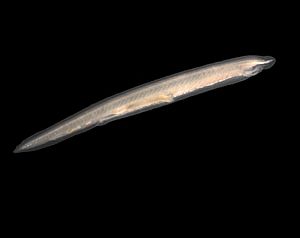Eumetazoa facts for kids
Quick facts for kids EumetazoaTemporal range: early Ediacaran (perhaps earlier) – Recent
|
|
|---|---|
 |
|
| A lancelet | |
| Scientific classification | |
| Kingdom: | |
| Subkingdom: |
Eumetazoa
Butschli, 1910
|
Eumetazoa (say: YOO-meh-tuh-ZOH-uh) is a special group of animals. It includes almost all major animal groups, like mammals, birds, fish, and insects. The only animals not in this group are sponges and a few others like Placozoa.
What makes Eumetazoa unique? They have true tissues, which are groups of cells working together for a specific job. They also have neurons, which are nerve cells that help them sense and react. Plus, their embryos (baby animals developing inside an egg or mother) go through a special stage called a gastrula.
Contents
What makes Eumetazoa special?
Eumetazoa are different from simpler animals like sponges because of a few key features:
- True Tissues: Imagine your skin, muscles, or nerves. These are all different types of tissues. Eumetazoa have these organized tissues, allowing for more complex body structures and functions. Sponges, on the other hand, have cells that work together but aren't organized into true tissues.
- Nervous System: Eumetazoa have neurons, which are the building blocks of a nervous system. This means they can sense their environment, move in coordinated ways, and even think (for more complex animals).
- Gastrula Stage: During their early development, Eumetazoa embryos form a cup-shaped structure called a gastrula. This stage is important because it sets up the basic body plan and the different layers of tissues that will develop.
What are the main Eumetazoa groups?
The Eumetazoa group is divided into two main parts based on their body symmetry:
Radiata: Animals with radial symmetry
The Radiata group includes animals like jellyfish and sea anemones. These animals have what's called radial symmetry. This means their body parts are arranged around a central point, like spokes on a bicycle wheel. You could cut them in many different ways through the center, and each half would look pretty much the same. They often don't have a clear "front" or "back."
Bilateria: Animals with bilateral symmetry
The Bilateria group is much larger and includes most animals you know, like humans, dogs, birds, and insects. These animals have bilateral symmetry. This means their body can be divided into two mirror-image halves (a left side and a right side) along only one line. They usually have a clear head end (front) and a tail end (back), and a top and a bottom. This type of symmetry allows for more complex movement and sensing of the environment.
See also
 In Spanish: Eumetazoa para niños
In Spanish: Eumetazoa para niños

